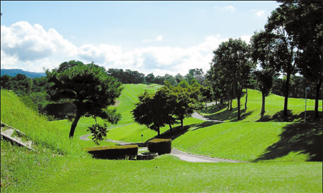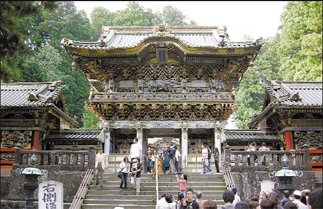Cool views from hot springs

An outdoor spa at the Kinogawa Hot Spring Resort.
The combination of rugged mountains, lake views and hot springs help make this prefecture one of the most popular tourist destinations in Japan.
Out of the many hot springs in the region, resorts in Nasu, Shiobara and Kinogawa have the best water quality.
Nasu, located 1,100 meters above sea level, developed into a hot spring town about 1,300 years ago. It’s dubbed “a deer spa,” named after an incident in which the town’s residents witnessed a wounded deer cleansing its wounds with water from the nearby hot springs. The spa here is noted for its milky color and potential for easing painful conditions such as arthritis.
Visitors can drink the water in the hot springs at Shiobara, a resort well known for its waterfall massage. The water has an alkaline base and is known for curing many skin diseases.
Most hot spring resorts here are equipped with outdoor spas. Soaking in hot water in the fresh open air is one of the most blissful experiences imaginable, especially in the early morning.
Ryokan, a traditional Japanese inn, is another relaxing experience you shouldn’t miss at the hot springs.

A golf course at Nasu-Shiobara [JoongAng Ilbo]
Tochigi Prefecture is a popular destination for golfers, mainly because they offer affordable rates all year round. About 20 golf courses are located within an hour’s drive from the hot springs in Nasu and Shiobara Prefectures. So you don’t need to spend hours on the road traveling between the hot spring and golf course.
Fees during the summer season (April to November) are 5,300 yen (40,000 won, $46) on weekdays, and 9,900 yen on weekends. In winter, the price drops 35 percent.
Most golf courses have hotels attached to hot spring spas. An overnight stay with a single round of golf costs about 11,500 yen on weekdays and 16,000 yen to 17,000 yen on weekends. You can also play an extra nine holes for an additional 1,000 yen to 2,000 yen.
In Tochigi, you’ll come across many ski resorts as well. Hunter Mountain Shiobara Ski Resort is about half an hour away from the hot spring town, heading northwest. The resort opens from Dec. 1 through mid-April the following year.
In the summer, the place turns into a giant flower park of four million lilies. During autumn you can enjoy the leaves from a gondola.
Nikko is often dubbed “the Kyoto of Tochigi Prefecture.” It’s full of cultural relics including shrines and temples that were registered in 1999 as World Cultural Heritage sites by Unesco. At shrines throughout the region nature and spiritual symbols merge into one.
The main attraction in Nikko is “Toshogu Shrine,” built in 1617 to honor Ieyasu Tokugawa, the first admiral of Edo Bakuhu. The main sanctuary in the shrine today honors the period’s third admiral, Iemisu Tokugawa. The shrine is adorned with 5,000 artworks by some of the leading masters of the Edo Period, including famous sculptures of monkeys and a sleeping cat.
Tochigi Prefecture is distinctive for its historical architecture and natural scenery. The popular vacation spot of Lake Chuzenji on Mount Nantai, located 1,500 meters above sea level, is 25 kilometers in radius, so big it takes some time just to drive around by car. Aside from luxury cabins, the area is full of pension houses and posh villas.

Toshogu Shrine. [JoongAng Ilbo]
After watching the waterfall for just a few seconds, you’ll witness an optical illusion. The water appears to be climbing up from the bottom instead of falling down from the top.
Nasu, Shiobara and Nikko are between 135 and 200 kilometers (84 to 124 miles) from Tokyo. The best way to travel between these towns is to stay at Utsunomiya in Tochigi Prefecture. It takes 50 minutes to travel from there to Tokyo on the bullet train. To get directly to Nikko, you can also use the regular train that departs from Shinjuku Station. It takes an hour and 56 minutes. The Kanto bus from Narita Airport takes two hours and 50 minutes to get to Utsunomiya. The distance between Nikko and Utsunomiya is about 25 kilometers, reachable both by bus or train. A bus to Kegonno Waterfall on Lake Chuzenji leaves at Nikko for 1,000 yen.
To get to golf clubs in the Nasu-Shiobara areas, take a direct flight from Incheon to Fukushima. Asiana Airlines travels three times a week, on Monday, Thursday and Saturday. From the airport, it takes about an hour by car. For group tours, the resorts often send out minivans, if reserved in advance.
By Park Gyeong-deok JoongAng Ilbo [myfeast@joongang.co.kr]










with the Korea JoongAng Daily
To write comments, please log in to one of the accounts.
Standards Board Policy (0/250자)